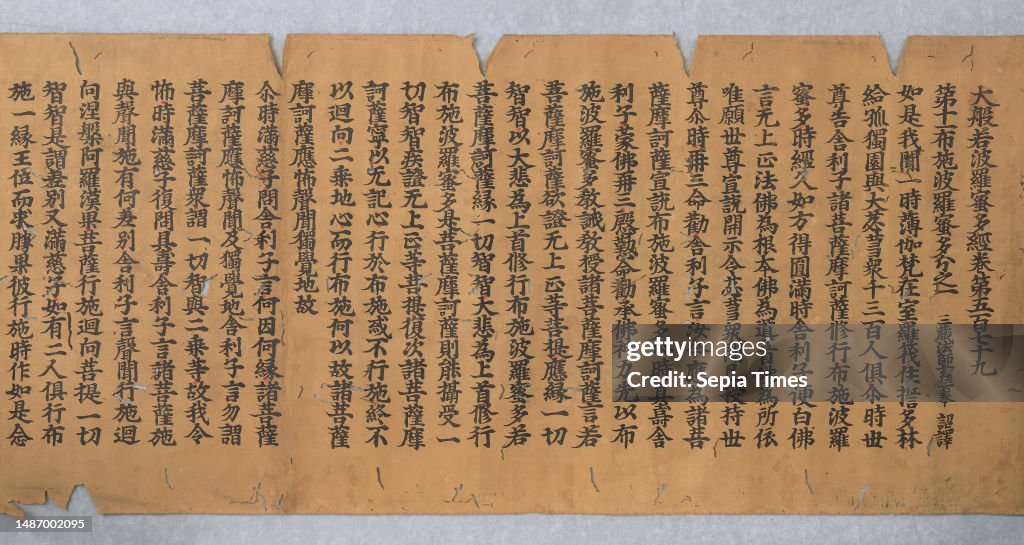Greater Sutra on the Perfection of Wisdom
Greater Sutra on the Perfection of Wisdom, Part 11, Chapter 579, c. 1300, Unknown Japanese, 10 3/8 × 365 1/2 in. (26.35 × 928.37 cm) (image)10 3/8 × 374 3/8 in. (26.35 × 950.91 cm) (mount, without roller), Woodblock print; ink on paper, Japan, 14th century, In the 600s, a Chinese Buddhist monk called Xuanzang (active c. 602–664) journeyed throughout India and neighboring countries studying and collecting sacred Buddhist texts. He returned to China with three versions of the Mahaprajnaparamita Sutra, or Greater Sutra on the Perfection of Wisdom, written in the Sanskrit language. At the heart of this voluminous sutra are teachings about figures called bodhisattvas (literally, 'awakened beings'), who attain buddhahood but remain attached to the mortal world in order to help others. Xuanzang used the three texts he brought from India to create a faithful version of the sutra in Chinese. Consisting of 16 parts and 600 chapters, this Chinese version soon found its way to Japan, where it remains the standard version of this influential sutra. A copy of the entire sutra, usually consisting of 600 scrolls, is kept in most Buddhist temples. The scroll displayed here represents just one chapter, #579, from a 600-scroll set printed around the year 1300. Temples of some Buddhist schools conduct regular recitations of the entire sutra. (Photo by: Sepia Times/Universal Images Group via Getty Images)

COMPRAR UMA LICENÇA
Como posso utilizar esta imagem?
385,00 €
EUR
Getty ImagesGreater Sutra on the Perfection of Wisdom, Fotografia de notícias Greater Sutra on the Perfection of Wisdom Obtenha fotografias de notícias premium e de alta resolução na Getty ImagesProduct #:1487002095
Greater Sutra on the Perfection of Wisdom Obtenha fotografias de notícias premium e de alta resolução na Getty ImagesProduct #:1487002095
 Greater Sutra on the Perfection of Wisdom Obtenha fotografias de notícias premium e de alta resolução na Getty ImagesProduct #:1487002095
Greater Sutra on the Perfection of Wisdom Obtenha fotografias de notícias premium e de alta resolução na Getty ImagesProduct #:1487002095475€175€
Getty Images
In stockNota: as imagens que representam eventos históricos podem conter temas ou ter descrições que não refletem a compreensão atual. Elas são fornecidas num contexto histórico. Saiba mais.
DETALHES
Restrições:
Contacte o representante local para todos os usos comerciais ou promocionais.
Crédito:
Editorial #:
1487002095
Coleção:
Universal Images Group
Data da criação:
02 de janeiro de 1754
Data do upload:
Tipo de licença:
Inf. sobre autorização:
Não tem autorização. Mais informações
Fonte:
Universal Images Group Editorial
Nome do objeto:
981_05_psm_221223_03682
Tamanho máx.:
5600 x 2979 px (47,41 x 25,22 cm) - 300 dpi - 11 MB
- Assistência,
- Bodhisattva,
- Budismo,
- Caneta e Tinta,
- Coleção,
- Criatividade,
- Espiritualidade,
- Fotografia - Imagem,
- Horizontal,
- Imagem,
- Imagem a cores,
- Interesse Humano,
- Japão,
- Levantar,
- Locais geográficos,
- Mensagem,
- Monge,
- Montanha,
- Ordem,
- Papel,
- Perfeição,
- Por volta do século 14 DC,
- Sabedoria,
- Sutra,
- Sânscrito,
- Tinta - Instrumento de Escrita,
- Índia,